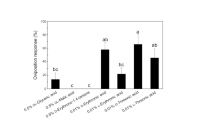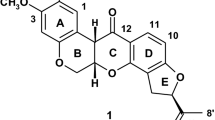Abstract
Several insecticidal compounds have been identified by bioassaydriven fractionation of avocado, Persea americana Mill, idioblast cell oil. A flash chromatography fraction of the oil showed substantial toxicity to early instars of the generalist insect herbivore, Spodoptera exigua (Hübner) (100% mortality after seven days). Following further fractionation, five biologically active compounds, 2-(pentadecyl)furan, 2-(heptadecyl)furan, 2-(1E-pentadecenyl)furan, 2-(8Z,11Z-heptadecadienyl)furan, and the triglyceride triolein, were identified. Several minor components were also tentatively identified, including 2-(1Z-pentadecenyl)furan, 2-(1E-heptadecenyl)furan, and 2-(1E,8Z,11Z-heptadecatrienyl)furan. Several 2-alkylfurans of this type have been reported previously from avocado (Persea spp.) and have received the common name of avocadofurans. The major compounds were tested individually for toxic and growth inhibitory effects. Individually, the compounds had low to moderate toxicity. Of these, 2-(pentadecyl)furan had the greatest effects, with an LC50 value of 1031 μg/g. At concentrations of 600 μg/g or higher in diets, larval growth was inhibited by >70% compared to controls. The analogous 2-(heptadecyl)furan had an LC50 value of 1206 μg/g, and also significantly reduced larval growth (>75% versus controls) at concentrations of >600 μg/g. The unsaturated analogs 2-(1E-pentadecenyl)furan and 2-(8Z, 11Z-heptadecadienyl)furan were less toxic. Triolein was only weakly toxic, with an LC50 value of 10,364 μg/g diet. Larval growth was inhibited only at concentrations of 7000 μg/g or higher. The potential of avocadofurans in insect control is discussed.
Similar content being viewed by others
REFERENCES
Adikaram, N. K. B., Ewing, D. F., Karunaratne, A. M., and Wijeratne, E. M. K. 1992. Antifungal compounds from immature avocado fruit peel. Phytochemistry 31:93–96.
Anonymous. 1980. Final report of the safety assessment for avocado oil. J. Environ. Pathol. Toxicol. 4:93–103.
Armstrong, W. W., Jr. 1964. Distribution of oil cells in Persea. Masters thesis. University of California, Riverside, 40 pp.
Biale, J. B., and Young, R. E. 1971. The avocado pear, pp. 1–63, in A. C. Hulme (ed.). The Biochemistry of Fruits and Their Products, Vol. 2. Academic Press, London.
Chang, C. F., Isogai, A. Kamikado, T., Murakoshi, S., Sakurai, A., and Tamura, S. 1975. Isolation and structure elucidation of growth inhibitors for silkworm larvae from avocado leaves. Agric. Biol. Chem. 39:1167–1168.
Cummings, K., and Schroeder, C. A. 1942. Anatomy of the avocado fruit. Yearbook Calif. Avocado Soc. 1942:56–64.
Esau, K. 1967. Plant Anatomy, John Wiley & Sons, New York, 767 pp.
Finney, D. J. 1971. Probit Analysis. Cambridge University Press, Cambridge.
Fraga, B. M., and Terrero, D. 1996. Alkene-γ-lactones and avocadofurans from Persea indica: A revision of the structure of majorenolide and related lactones. Phytochemistry 41:229–232.
Gaydou, E. M., Lozano, Y., and Ratovohery, J. 1987. Triglyceride and fatty acid compositions in the mesocarp of Persea americana during fruit development. Phytochemistry 26:1595–1597.
Ikedawa, N., Honma, Y., Morisake, N., and Aakai, K. 1970. Migration of the double bond in the side chain chain of sterols with iodine. J. Org. Chem. 35:4145–4148.
Kashman, Y., Neeman, I., and Lifshiftz, A. 1969a. New compounds from avocado pear. Tetrahedron 25:4617–4631.
Kashman, Y., Neeman, I., and Lifshiftz, A. 1969b. Six new C17-olefinic and acetylenic oxygenated compounds from avocado pear. Isr. J. Chem. 7:173–176.
Kobiler, I., Prusky, D., Midland, S., Sims, J. J., and Keen, N. T. 1993. Compartmentation of antifungal compounds in oil cells of avocado fruit mesocarp and its effect on susceptibility to Colletotrichum gloeosporioides. Physiol. Mol. Plant Pathol. 43:319–328.
Lie Ken Jie, M. S. F., and Lam, C. H. 1978. Fatty acids, Part XVI: the synthesis of all isomeric C18 furan-containing fatty acids. Chem. Phys. Lipids 21:275–287.
Magalhaes, Alves H., Coxon, D. T., Falshaw, C. P., Godtfredsen, W. O., and Ollis, W. D. 1970. The avocatins—a new class of natural products. An. Acad. Bras. Cienc. 42(suppl.):45–48.
Murakoshi, S., Isogai, A., Chang, C. F., Kamikado, T., Sakurai, A., and Tamura, S. 1976. Effects of two components from the avocado leaves (Persea americana Mill.) and the related compounds on the growth of silkworm larvae, Bombyx mori L. Jpn. J. Appl. Entomol. Zool. 20:87–91.
NÉeman, I., Lifshitz, A., and Kashman, Y. 1970. New antibacterial agent isolated from the avocado pear. Appl. Microbiol. 19:470–473.
Patana, R. 1969. Rearing cotton insects in the laboratory. U.S. Dep. Agric., Agric. Res. Serv., Prod. Res. Rep. 108:1–6.
Platt, K. A., and Thomson, W. W. 1992. Idioblast oil cells of avocado: Distribution, isolation, ultrastructure, histochemistry, and biochemistry. Int. J. Plant Sci. 153:301–310.
Platt-Aloia, K. A., and Thomson, W. W. 1992. Ultrastructure of avocados: Ripening, chilling injury and isolation of idioblast oil cells. Proceedings, Second World Avocado Congress, Anaheim, California, 1991.
Platt-Aloia, K. A., Oross, J. W., and Thomson, W. W. 1983. Ultrastructural study of the development of oil cells in the mesocarp of avocado fruit. Bot. Gaz. 144:49–55.
Previtera, L., Merola, D., and Monaco, P. 1985. Acetogenins from the aquatic plant Elodea canadensis. Phytochemistry 24:1838–1840.
Prusky, D., Keen, N. T., Sims, J. J., and Midland, S. L. 1982. Possible involvement of an antifungal diene in the latency of Colletotrichum gloeosporioides on unripe avocado fruits. Phytopathology 72:1578–1582.
Prusky, D., Kobiler, I., Fishman, Y., Sims, J. J., Midland, S. L., and Keen, N. T. 1991. Identification of an antifungal compound in unripe avocado fruits and its possible involvement in the quiescent infections of Colletotrichum gloeosporioides. J. Phytopathol. 132:319–327.
Rodriguez-Saona, C., and Trumble, J. T. 1996. Toxicity, growth, and behavioral effects of an oil extracted from idioblast cells of the avocado fruit on the generalist herbivore beet armyworm (Lepidoptera: Noctuidae). J. Econ. Entomol. 89:1571–1576.
Rodriguez-Sanona, C., Millar, J. G., and Trumble, J. T. 1997. Growth inhibition, insecticidal, and feeding deterrent effects of (12Z, 15Z)-1-acetoxy-2-hydroxy-4-oxo-heneicosa-12, 15-diene, a compound from avocado fruit, to Spodoptera exigua. J. Chem. Ecol. 23:1819–1831.
SuperAnova. 1989. Abacus Concepts Inc., Berkeley, California.
Weyerstahl, P., Marschall, H., and Scora, R. W. 1993. Constituents of the leaf essential oil of Persea indica (L.) K. Spreng. Flavour Fragrance J. 8:201–207.
Zhang, M., Chaudhuri, S. K., and Kubo, I. 1993. Quantification of insect growth and its use in screening of naturally occurring insect control agents. J. Chem. Ecol. 19:1109–1118.
Author information
Authors and Affiliations
Rights and permissions
About this article
Cite this article
Rodriguez-Saona, C., Millar, J.G., Maynard, D.F. et al. Novel Antifeedant and Insecticidal Compounds from Avocado Idioblast Cell Oil. J Chem Ecol 24, 867–889 (1998). https://doi.org/10.1023/A:1022325601724
Issue Date:
DOI: https://doi.org/10.1023/A:1022325601724




